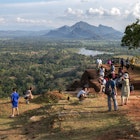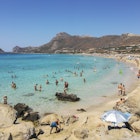If anywhere deserves to be called a year-round destination, it’s Sri Lanka. This small island boasts a diverse collection of microclimates – when it's raining on one stretch of coast, the weather is perfect for surfing or sightseeing on another.
This close to the equator, daytime temperatures hover at around 30°C (86°F) all year, so you won't have to worry too much about getting cold except in the hills. That said, it's worth considering how the two monsoon seasons affect different parts of the island before planning a trip, though it's easy to hop across the island if you get your forecasts confused.
On most trips, people mix up beach time with detours to national parks, and trips to the cooler highlands and ancient cities in the middle of the island, so you'll experience a mix of heat and cool on pretty much every visit.
And the Sri Lankan calendar is chock-full of festivals and holidays, offering a unique cultural highlight for visitors almost every month. Whether you’re looking to hit the beach, spot wild elephants, hike to the summit of Adam’s Peak, or simply avoid the tourist crowds, here are the best times to visit Sri Lanka.
December to March is the best time to hit the beach
Sri Lanka’s high season coincides with the driest weather in the south and west of the country. Popular beach resorts such as Hikkaduwa and Mirissa are at their most idyllic, but also busiest, aligning with excellent surfing conditions on the south and west coasts. However, the Maha monsoon season (October to January) keeps the East, the North, and the Ancient Cities humid and rainy at this time of year.
Sri Lanka is a year-round wildlife-watching destination, but the best times to spot elephants, leopards and buffalo is during the main November-to-April tourist season. All the big parks are open and animals start to gather around water holes, making them easier to spot. However, the island's greatest wildlife spectacle – the "Gathering" of elephants at Minneriya National Park – takes place from July to September.
By December, high season is in full swing, with bathers jostling for towel space on the beaches along the south and west coasts. The pilgrimage season on Adam’s Peak, when pilgrims of all faiths climb the sacred summit, starts in December and lasts until mid-April.

The end of December sees the island gear up for Christmas, which is celebrated enthusiastically by Sri Lanka’s Christian community. Followers of other faiths also join in secular events over the holidays – expect over-the-top decorations aplenty.
January is the peak of the tourist season in Sri Lanka. Crowds may be at their largest, and prices at their highest, but fine weather in the south and west makes this a particularly appealing time for a beach holiday, and many popular towns host major festivals during the first month of the year.
Events to note on your calendar include Duruthu Perahera in Colombo, a lavish festival of lights, dances, and parades to celebrate the first visit to Sri Lanka by the Buddha. On the south coast, Galle's more sedate annual literary festival takes over the city's Unesco-protected fort.
Visitor numbers are still high in February, with wintering Europeans baking themselves on the beaches in the warm winter weather. This is a busy month for Sri Lankans, with Independence Day early in the month, commemorated with festivals, parades, fireworks, and sporting events across the nation.
The festival of Maha Shivaratri in early March (or late February) brings another flurry of activity, with Hindus commemorating the marriage of Shiva to Parvati with all-night vigils and ceremonies. It’s the most important festival for Shaivite Tamils, who comprise the majority of Sri Lanka’s Hindus.
The Muslim festival of Ramadan moves forward 11 days each year relative to the Gregorian calendar – in 2024 and 2025, the month of fasting begins in March and February respectively, with some Muslim-owned businesses closing during daylight hours.

September to October and April are the best times for exploring the whole country
Squeezed between the two monsoon seasons, Sri Lanka’s twin shoulder seasons see agreeable weather right across the country, with fewer crowds and lower prices. April, however, does coincide with the busy Sinhala and Tamil New Year, which can cause transport troubles.
This is a good time for trekking in the Hill Country or climbing Sigiriya, as the weather is mostly dry but not as hot as in the height of summer. From August to September, hundreds of elephants group together for several weeks in Minneriya National Park during the annual Gathering. It's one of Asia’s great wildlife spectacles, and you have a good chance of seeing baby elephants.
October can be a bit unpredictable, with the summertime Yala monsoon fading and conditions building towards the Maha monsoon. Thunderstorms can arrive in the afternoons, and rain is common, but there's still good surfing on the east coast. Just add a raincoat to your list of things to pack.
After the busy winter season, April is warm and dry across the majority of the country, and prices fall as the peak season crowds depart. Although Christians comprise only six percent of Sri Lanka’s population, Christian festivals – including Easter, which usually falls in April – are still celebrated with gusto.
A more significant event in April is Avurudu, the Sinhalese and Tamil New Year. New Year’s Eve and New Year’s Day are official holidays, and over the days before and after, buses and trains are jammed as people flee from big cities to home villages.

May to August is the best time to avoid the crowds
The low season in Sri Lanka starts with the arrival of the Yala monsoon in May, which pounds the west and south coasts as well as the Hill Country until August. Accommodation prices during this period are generally lower and crowds are thinner.
This is the best time for trips to Jaffna in the North and the chilled-out resorts along the East Coast, such as Arugam Bay, known for its consistent point breaks and laid-back surf scene.
Despite the rain, many must-see festivals take place during this period, including Vesak Poya, a two-day festival in May when colored lights adorn every Buddhist home, shop, and temple. There's also the vibrant Esala Perahera in Kandy, where thousands of dancers and drummers form a giant procession through the town.
The rains dampen tourism in June, except on the East Coast beaches, which stay drier at this time. Meanwhile, another major Buddhist event, the Poson Poya, gets underway, celebrating the introduction of Buddhism to Sri Lanka. Major festivities take place in the temples of Anuradhapura, and thousands of white-clad pilgrims ascend the 1843 calf-busting steps to Mihintale’s sacred stupa.

For travelers who aren’t easily disheartened by the odd downpour, summer is a good time to be in Sri Lanka. The focal point for the country’s Buddhists is Esala Perahera in July or August, which lasts for 10 days. The Kandy Esala Perahera is legendary, but smaller parades are held across Sri Lanka. Many celebrations feature dancers, drummers, and stilt walkers who practice all year for the occasion.
Another large-scale procession takes place in Colombo as part of the Hindu festival of Aadi Vel, which sees the gilded chariot of Murugan (Skanda), the Hindu god of war, ceremonially hauled through the city’s streets.
August marks the last month of low season, with the Yala monsoon slowly beginning to ease. To maximize the chance of avoiding the rain, head north to Jaffna, where the famous Nallur Kandaswamy Kovil hosts the spectacular Nallur Festival (sometimes starting in July). The event climaxes with parades of juggernaut floats and gruesome displays of self-mortification by entranced devotees.

Poya (full moon) days
It is worth noting that every poya (full moon) day is a holiday in Sri Lanka. White-clad pilgrims gather at Buddhist shrines and buses, trains, and accommodations fill up, especially if the full moon falls on a Friday or Monday. No alcohol is supposed to be sold on poya days and many bars close (though some hotels discreetly provide cold beer "under the table"). This is a particularly atmospheric time to visit the sacred Sri Maha Bodhi tree at Anuradhapura, grown from a cutting taken from the tree under which Buddha attained enlightenment.











